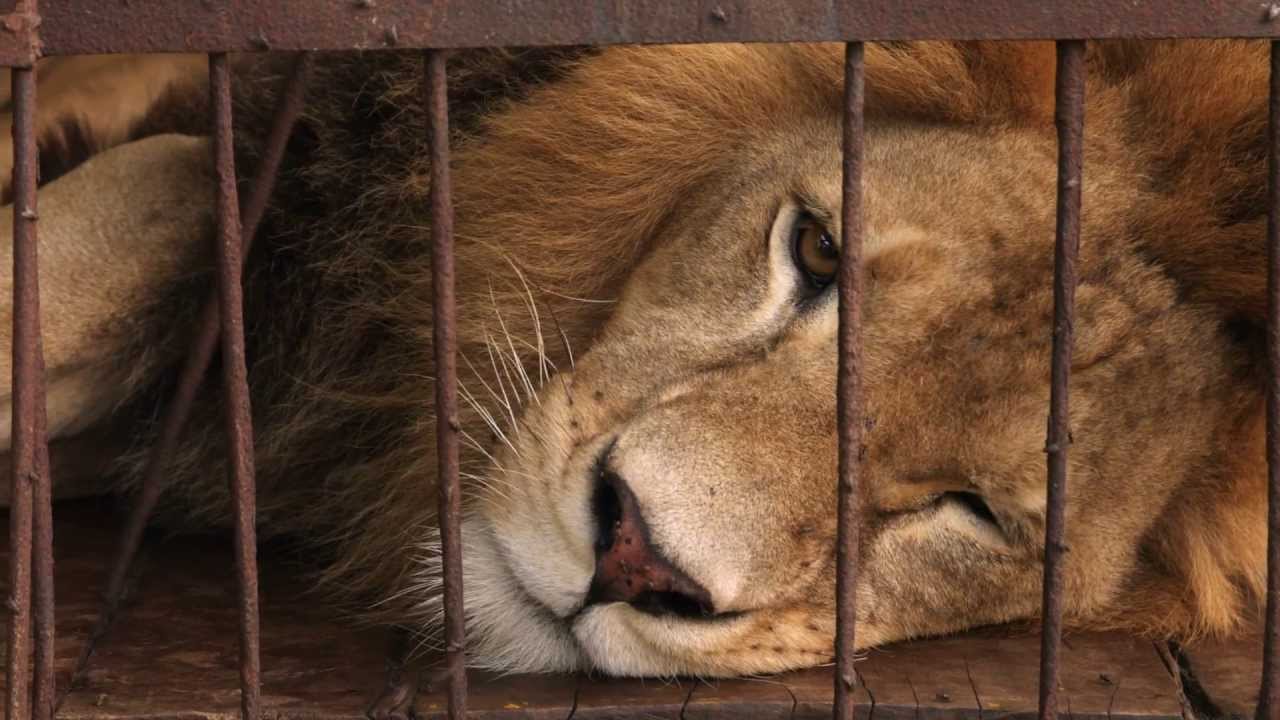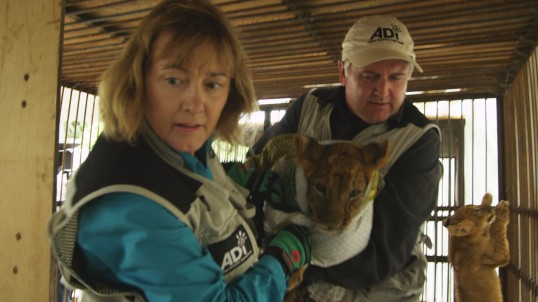Remember the documentary Blackfish from earlier this year that exposed the ugly side of using killer whales for entertainment? After seeing that film, which today was announced as one of the short list of contenders for the upcoming Best Documentary Oscar, I swore off ever returning to places like Sea World. Watching Tim Phillips’ great new documentary Lion Ark has produced a similar result: I can never again in good conscience buy a ticket to the Ringling Bros. Circus or any other venture that features wild animals performing tricks for our amusement. You may well feel the same way after you watch this riveting film and see how these animals are treated in such environments. But don’t worry, animal lovers, Lion Ark is not just an expose of abuse — with its behind-the-scenes footage of one of the most ambitious animal rescues ever undertaken, I’d go so far as to say it’s the feel-good movie of the year!
Director Tim Phillips, along with his wife, Jan Creamer who is seen in the film, are involved with an animals rights group called ADI (Animal Defenders International). The organization spearheaded a shocking undercover investigation in Bolivia that led to a ban on animal circuses in that country. But many circuses defied the law, and kept their captive lions in deplorable conditions as they tried to stay two steps ahead of the authorities. Seeming more like an action-packed thriller than a documentary, Lion Ark documents the daring rescue of every single lion that was still being mistreated in Bolivia as well as the awe-inspiring airlift of these animals to a sanctuary in the United States. It is a story of bravery, compassion, camaraderie, and determination, and the rare animal rights film that will leave you cheering and feeling hopeful. I recently spoke with director Tim Phillips about this important film.
 Danny Miller: What an inspiring film, I was on the edge of my seat throughout! The first thing I want to know is how the lions from the film are doing.
Danny Miller: What an inspiring film, I was on the edge of my seat throughout! The first thing I want to know is how the lions from the film are doing.
Tim Phillips: They’re doing fantastically. They’ve grown a lot, and are so much stronger. The tiny cubs that we rescued are now huge, they’ve outgrown their parents. When you go to the sanctuary in Colorado, you can see how they’ve blossomed. They’re living in prides, in these big family groups, and as close as possible to the way they’d be living in the wild.
I was stunned to see how quickly the lions improved as soon as you got them away from those appalling conditions in the circuses. Were you shocked at how fast they started adapting to a more human life?
I wouldn’t say shocked, exactly, but you can see that even when we made the smallest improvements in their situation, they became so much more engaged with their environment. They became faster, quicker, and more playful, even in the compound in Bolivia, and they began to communicate with each other a lot more. It was as if they were already becoming a pride. It was such a thrill to see them transforming from these lethargic beaten-down creatures into the magnificent animals that they are.
The airlift seemed enormously complicated and risky. Were you worried it wouldn’t go as well as it did?
There is always a fear when you’re airlifting such animals because you have to cage them up for long periods. Some of the lions had been really starved and their bodies were very damaged. It was a major concern when we were moving them that if one became ill during the ten-hour flight, they could all go downhill very quickly. But happily, they all thrived.
I can only imagine how costly the rescue and airlift were. Was all of that done with the funds you raise in the organization?
Yes, everything we do is funded by public donations. That’s what makes it possible for us to put people undercover and expose the findings and secure laws like the ones that were passed in Bolivia. And, of course, these huge rescues. In the film we thank Bob Barker because he gave a very large donation to us that we specifically earmarked for the airlift. Needless to say, clearing an entire country of circus animals is a very expensive thing to do!
The sanctuary in Colorado looks amazing. Is it just not possible to put such animals back into the actual wild?
No, not really. There are lots of reasons that would make that very difficult. When wild animals spend a lot of time living in other countries, you can never really tell what diseases they pick up. They might pick up things that don’t necessarily affect lions but can massively damage other parts of an eco-system if they were sent back to their original countries. And these animals have never hunted, it’s very doubtful that they’d be able to survive on their own.
The actual collection of the animals from various circuses is such a suspenseful part of the film. Did you guys ever worry for your safety in those situations? Some of these people seemed like rather unsavory characters!
There were a few tense moments and several times when the authorities warned us that certain circuses said they were going to attack me and Jan and beat us up. It didn’t come to that but we occasionally brought police with us. There was often a lot of shouting and shoving and pushing about but generally we got through those situations and things calmed down.
You obviously had the law on your side. Was it the threat of facing jail or huge fines that eventually made them relent?
Yes, I think that was ultimately what won through. These people were definitely defying the law. There was this one circus that kept constantly moving to avoid us. We placed one of our people there undercover working as a clown so from then on we always knew where they were! We just moved into the town one night and raided them early in the morning. But yes, sometimes it got very tense.
After seeing the film Blackfish I decided I could never again go to Sea World. This film made me realize that I can no longer support circuses that feature animals even though I grew up enjoying those and used to frequently take my kids to the circus. Do you think there is any justification for having animals be involved in such activities or do you think all such circuses need to come to an end?
I think they have to come to an end. With the circuses, in particular, no other animals have to spend almost their entire lives in such temporary accommodations. That will always be a huge problem. And then having to do all these shows and tricks which leads to constant contact with people and physical violence because they are dangerous animals and so these people have to dominate them because they’re working with them in such restricted space. When you stop and think that that’s just in the name of a few minutes of entertainment, it just has to stop.
Have you been able to help pass laws banning animal circuses in other countries?
Oh, yes, there’s been an unprecedented wave of countries that are now banning the use of wild animals in circuses. In Asia you’ve got countries such as China and Singapore and Taiwan. In Europe, you have Portugal, Greece, the Czech Republic, and now Great Britain has some legislation drafted. In South America, there is Bolivia, Paraguay, Peru, Ecuador, and Columbia, and in Central America, El Salvador and Costa Rica.
Wow, that’s amazing.
The 25 countries who have passed such laws are all very different socio-economically and yet they’re all saying, “No this shouldn’t happen, we should not be treating animals like this just for entertainment.”
Where do things stand in the United States?
There was some legislation presented this year that didn’t pass. We’re hoping for more support next year. It’s unlikely it will get through on its second go, but it will happen eventually. There is no longer any real appetite in the U.S. for animals in circuses, the few that still have them have declining audiences and there are now many successful circuses without animals. I think there’s a lot of passion for this issue in the U.S. It’s no accident that the lions from Bolivia found refuge in sanctuaries in this country.
But you must have received push-back from places like Ringling Brothers and other big corporations.
Yes, we do get that and we have engaged in debate with those people in the press and in town hall meetings. But the amount of violence that has been caught on film, including at the big-top circuses, is just staggering. So much of that violence shows a culture of intimidation and that these animals are forced to live in terribly limited environments. That’s why it’s got to change.
I’m sure there are many Americans who want to think, “Well, maybe that goes on in these other countries, but surely not here in the United States!”
Yeah, we’ve done a lot of Q&As at screenings and film festivals and people always ask what the difference is between what they see in the film and what’s going on in circuses here. Often it’s just that the cages look shinier — they’re clean, they’re freshly scrubbed, but in the end do the animals actually have better lives? Not really. ADI did an exposé on a group of bears that are currently touring the United States. We followed them and found them living most of the time in this awful truck. They’re taken out to do their show — ride bikes, do things that are really archaic, it seemed like something from 150 years ago — and then put back into the truck after the show. It was like they were living in dungeons, these little tiny pens, even if they were shiny, clean, and sanitized. I would say that life for those bears was even worse than for the lions in Bolivia, even the eight you see in the film that were living in that small disgusting cage — at least they were able to look out into the world. The bears in America have absolutely nothing.
Are you also against zoos, or does it depend on how they’re set up?
There’s obviously a huge variation out there. We certainly think that deliberately taking any animals from the wild or deliberately breeding them for incarceration is wrong. Doing that simply to give people a chance to see these animals is not a good reason to take everything of value from their lives. But the truth is that we’re always going to be stuck with wild animals in captivity to some extent. Animals taken from drug dealers or rescued countries like Bolivia, and so forth, but there needs to be a real shift towards keeping these animals in a way that suits them. We need to have more sanctuaries that specialize in certain species so that we can do the best for those species. I think the Lion Ark lions highlight how you can still have animals that you can go and visit but it’s not intrusive, they’ve got lots of space, and they live very happily in appropriate family groups.
Click here for more information on Lion Ark including upcoming screenings.


